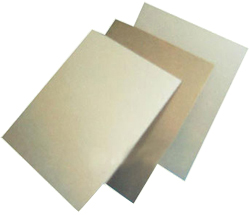eLearning Series
9. Cheap Paper
Many years ago, I built custom homes up in the mountains of Colorado, near some of the large ski resorts. I didn’t want to pay for real business cards, so I printed out a few using my inkjet printer and micro-perforated cards. Unfortunately, it rained a lot that year, so when I was handed out these business cards during a drizzle, the ink tended to run. Not quite the professional image I was trying to project. I opted for real business cards soon after.  The type of paper you choose can impact how your customers view you. How the paper feels in someone’s hand, including the weight of the paper, its color and characteristics, is a subject that many people spend years mastering. The most important thing to understand is that all paper reflects light. How the paper is produced, including the paper’s finish, weight, and opacity, determine how a pair of human eyes will react to images and text printed on the paper’s surface.
The type of paper you choose can impact how your customers view you. How the paper feels in someone’s hand, including the weight of the paper, its color and characteristics, is a subject that many people spend years mastering. The most important thing to understand is that all paper reflects light. How the paper is produced, including the paper’s finish, weight, and opacity, determine how a pair of human eyes will react to images and text printed on the paper’s surface.
Finish: Glossy paper has a smooth, opaque finish, so it reflects more light (ideal for vibrant photos). A matte finish is more porous and scatters light, reflecting less color back to the viewer (matte is better for black and white images or more muted tones).
Weight: The thickness and density of the paper contributes to its weight. The heavier the weight, the less likely your direct mail campaign will crease, fold or wrinkle. (Reminds me of my junior high school teacher saying, “Do not fold, spindle or mutilate the corners.”) The normal paper you put in a laser printer is 20 pound paper. Cardstocks range in weight between 60-120 pounds. If you’re doing a postcard campaign, you’ll need to use a cardstock weight. The heavier the paper, though, means that you’ll pay more in postage. That’s why those terms and conditions your credit card company mails out once a year is printed on paper that weighs as little as possible.
Opacity: How much light can pass through the paper is referred to as opacity. Thin paper will often allow light to pass through it, but if you want a semi-transparent cover, you can use a paper that has a lower density (but still is a heavy enough weight) to give a solid feel to the printed piece. So with all of these choices, how do you know the right options for your direct mail campaign? Most of the time people start with the cheapest option, and then work up from there.
The Cheapest Option: Plain white paper or cardstock is usually the cheapest option for printing. Just keep in mind that it won’t differentiate your organization, product or service, and it might lump you in with others that use a generic and plain option.
Personalized Letter to Executive: If you’re trying to break through the clutter by sending a personalized letter to a C-level executive, using a cheap 20 pound paper that you ran through your laser printer is a great way to have your message ignored or recycled. A message sent on plain white paper isn’t going to have the same effect as a letter printed on a cotton or linen paper. Ideally, you should have your logo embossed or printed on the stationary as well. Holiday-speckled
Paper: If you’re putting together your holiday cards, you might want to use a paper that has a sheen on it, or sprinkles, that reinforces the holiday season. Sprinkles grab attention and reflect light like nothing else.
Glossy: If part of your direct mail campaign uses a dynamic photograph, a glossy finish might be a great way to make sure the image ‘pops’ off the page. A gloss finish gives you a message that is smooth and clean, and brings a professional look. With a glossy paper, colors look richer, deeper and more vibrant.
Matte Finish: Matte prints don’t reflect light, and are less likely to attract dust, fingerprints, and can be easier to read in intense sunlight. Matte works much better for black and white photos, but can make color photos look dark and dull.
Recycled: If you are an organization in the environmental space, you probably want to go with recycled paper and not use a glossy UV coating for your mailings. A natural fleck in the paper can be a subtle touch as well. Recycled paper is more expensive, so if you use it, make sure that you also put the recycled logo on your mailing so that your audience knows you’ve spent the extra money in your efforts to save trees. You can also use vegetable-based ink, too, to ease in the recycling process. Crazy as it may seem, people do pay attention to this and make purchasing decisions based on carbon offsets and earth-friendly marketing materials.
